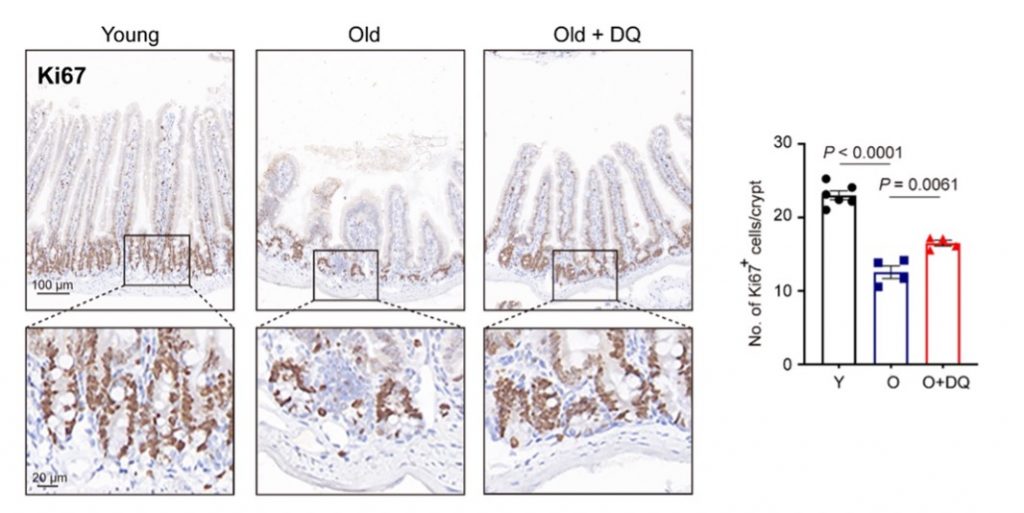Key Points:
- Treatment with D+Q reduces the number of dead cells in the intestinal wall of aged mice.
- D+Q increases intestinal villi and crypts — structures that increase the absorption of nutrients from the food we eat.
- Senolytic treatment with D+Q increases intestinal stem cells — cells that regenerate the intestinal wall.
The aging process is associated with the gradual deterioration of our organs, triggering various health conditions that negatively impact our quality of life. In the case of the gastrointestinal (GI) tract, its deterioration is linked to a lack of nutrient uptake from the food we eat, leading to nutrient deficiencies that can cause fatigue, swelling, or illness.
Now, researchers from Huazhong University in China have found that treatment with D+Q can regenerate the GI tract and combat its deterioration. As reported in Aging and Disease, Luo and colleagues also found that D+Q treatment removed dead intestinal cells and increased tissue-regenerating intestinal stem cells. The authors conclude,
“Our investigation provides evidence supporting the potential of implementing senolytic cocktail D+Q as a means to revive senescent small intestines.”
Dasatinib Plus Quercetin Rejuvenate the Intestinal Wall
To determine the effect of D+Q treatment on age-related GI tract decline, Luo and colleagues fed aged mice (16-months-old, equivalent to about 52 human years) D+Q every other week for 4 months. They then compared the D+Q-treated aged mice with young mice (3-months-old, equivalent to about 22 human years) and aged mice that did not receive D+Q (untreated).
As expected, the untreated, aged mice had a greater number of dead intestinal cells than young mice, suggesting that dead cell clearance is disrupted in aged mice. This is because dead intestinal cells are usually cleared away to alleviate intestinal deterioration. However, D+Q treatment was shown to improve dead cell clearance, as D+Q-treated aged mice had a similar number of dead intestinal cells as young mice.

The more crypts and villi we have in our intestinal wall, the greater the surface area available for nutrient absorption. By measuring crypt and villi numbers, Luo and colleagues found that D+Q treatment partially prevented the age-related reduction in these critical anatomical structures. These results suggest that D+Q can potentially increase nutrient absorption rates, especially in old age.

Intestinal stem cells give rise to new adult intestinal cells that compose the intestinal wall’s crypts and villi. While Luo and colleagues found reduced intestinal stem cells in untreated, old mice compared to young mice, D+Q treatment elevated the number of intestinal stem cells. These findings suggest that D+Q can stimulate intestinal stem cell growth to enhance intestinal wall rejuvenation.

Senolytics Rejuvenate Multiple Organs
The findings of Luo and colleagues suggest that D+Q treatment slows intestinal aging by clearing dead intestinal cells and stimulating the growth of new intestinal cells. D+Q has also been shown to slow the deterioration of other organs, including muscle, bone, and heart in rodents. Moreover, other senolytics have been shown to combat age-related kidney disease and Alzheimer’s disease in rodents. While human studies are needed, these animal studies suggest that senolytics could slow the aging process.